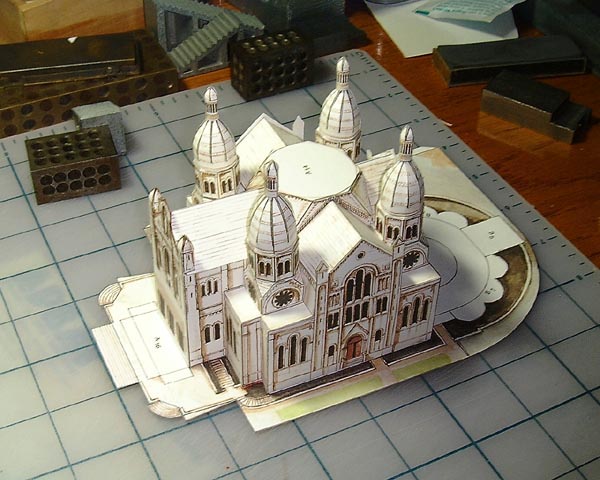
Half finished model
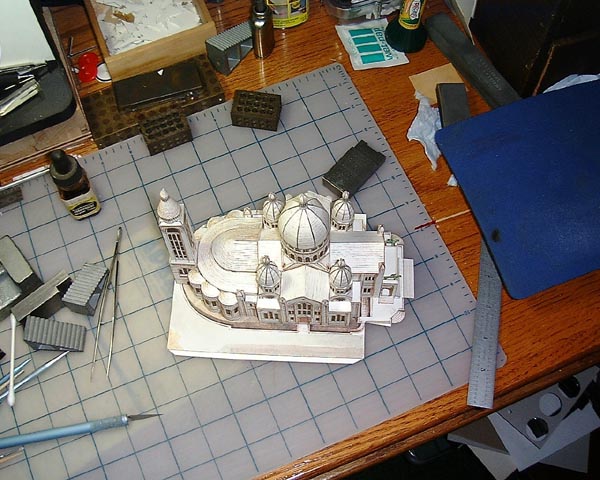
Completed model, top view
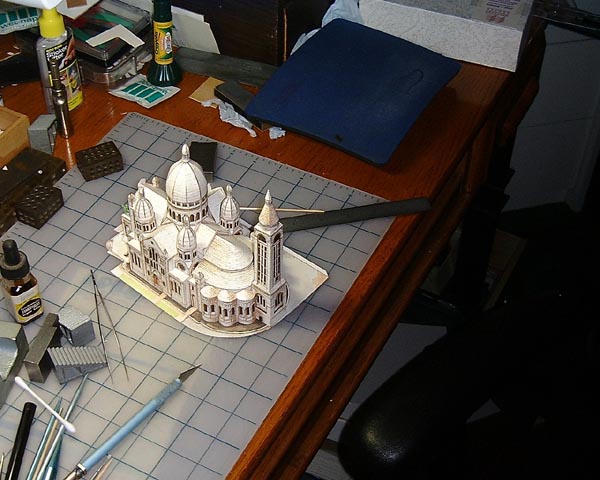
Completed model
This model of Montmartre comes in a soft cover book and as I recall, I purchased it from PMI a few years back. Published by Editions Pascaline, 1988. ISBN number 2.905169.18.7
Montmartre district of Paris is home to the famous Moulin Rouge Cabaret as well as many others, which were often frequented by such famous artist as Toulouse-Lautrec, Vincent van Gogh and Oscar Wilde. It sits on a hill approximately 398 feet high and looks out over all of Paris. The Sacré-Coeur basilica is the center- piece of this display; in fact, one might say it is a complete model unto itself. For this reason, I have titled this as Part 1 while the remaining un-built pieces in Montmartre, when assembly is completed will be Part 2 of this review.
The entire Basilica consists of 32 separate pieces and is marked as sub assembly part A and B. The models over-all Sepia tone gives it a rather stylish appearance. Construction is quite simple and causes no great concerns except for a few minor points that you should look out for. First, is the bell tower behind the Apse, be careful that the tower does not become warped. This is one piece and I mistakenly glued the upper section together first. When I went to glue the lower section, I noticed a slight warp was occurring. What probably would have been a better idea would be to separate the two sections, glue them and then attach it to the base.
The next concern is the three semi-circle structures on each side of the Apse. Again the assembly is one piece. The concept is great, but a pain to attach properly. If I had to do it over, I would cut apart each little structure, curve it, form the roof and glue the roof down unto the structure. Next I would cut two semi circles from heavier card stock and glue them inside the semi circle structure for reinforcement; and then attach it to the wall of the Apse and the base. (Repeat six times)
A sort of un-written cardinal rule among modelers, as we know, is NEVER toss out anything that might have a future use in achieving our goal of producing that one model that will be pure perfection. Here is a case of the right thing at the right time. My wife (bless her!) purchased a Wizard scented oil freshener, the kind you plug into an outlet and is suppose to give off a fragrance for several weeks. The bottle containing the oil has a large green cap shaped much like the nose cap of a rocket or bomb. A little blunt perhaps at the tip but never the less the over all shape is great. “Here honey, can you use this!” as she brought it to me. “Yea, thanks!” not having the least idea if or when I might ever use it.
I know now, that this little green cap was a gift sent to me from the “Gods of Modeling”. When the time came to form the main dome on top of the basilica, that green cap proved to be the perfect shape and fit. One rarely runs across something that is the right tool at the right time. The dome turned out perfect and I could not be more pleased with the results.
A simple trick, which is illustrated in a sketch on the inside back cover is the use of a small modelers paintbrush. Using the tip of the handle end of the brush helps in forming the pointed peaks of the smaller caps that fit on top each dome.
I found that very little touch up was needed on any of the edges, but I do have some liquid watercolor in Sepia tone. This I purchased many many years ago and don’t even know if it is still available. The bottle says Dr. PH Martin’s Synchromatic Transparent Water Color, Number 10 Sepia. It was a perfect match and worked great where needed.


Completed model, top view

Completed model
Part 2 – The remaining diorama
As mentioned in Part 1, the model of Montmartre comes in a soft cover book published by Editions Pascaline, 1988. ISBN number 2.905169.18.7. Montmartre is in Paris and is home to the famous Moulin Rouge Cabaret among many others that were often frequented by famous artist. It sits on a hill approximately 398 feet high and looks out over all of Paris.
Having finished the Basilica, it was time to turn my attention to building the diorama upon which the Basilica will sit. There are many minor problems that will need to be addressed, if the diorama is to look as good when completed. The accompanying photos will show that over all the finished model looks quite well, but it took a little work.
Following the alpha sequence set up in part 1, the Basilica; part 2 contains approximately 62 pieces in five separate sections. As assembly progressed, I realized that one must remove most of the gluing tabs on the structures. Leaving them attached only interferes with the forming of these structures while trying to keep their integrity. Many of the buildings will not fit the outline on the ground plate, so you will need to adjust them accordingly. In assembling the diorama, here are a few things you might watch out for and correct as you go along.
This is the foundation upon which the entire structure will rest when finished. Here I found it necessary to add several extra support pieces to prevent any of the ground pieces from sagging later. This extra supporting is probably nothing new to any of our fellow card modelers who have had experience building architectural models. Parts1, 4, and 9 form the back wall and should be butt joined and glued to the ground plate as one long strip. Pay close attention to the starting and ending point when gluing. Follow the curve as close as possible, I was not as careful as I thought, and as a result the Basilica has about a 3 to 5mm over hang at the rear of the diorama.
This part of the assembly requires some modification to several pieces. Rather then go into full details, I believe it to be suffice to say that all of the step pieces leading up to the Basilica need to be carefully test fitted and trimmed or separated if necessary before any gluing takes place. The grassy areas in front that will face you also need to be carefully test fitted and trimmed. I found that a slight curving of one piece (part 9) helped it fit better although it is not curved in the photo of the publishers model as shown on the cover of the book.
These sections comprise most of the buildings in the diorama. Here I can only add that you study how each building is to look once it has been assembled. Separate each building into as many separate components as necessary. If you try to assemble them as one piece, many will not line up correctly or fit the outline as shown on the ground plate. Once I was satisfied with all the structures and the over all appearance, I attached the Basilica to the base. I left this as the last item to be attached for two reasons. First, ease in handling the diorama so as not to accidentally knock off any of the Basilica’s spires or domes. Secondly, it is a large structure when compared to the minute size of the other buildings. It was just easier to attach and adjust the other buildings without interference from the Basilica.
Now that it is complete, I would say that the building time was probably doubled in efforts to correct these problems. When complete however; it makes into an impressive little diorama that is sure to have people look at in awe. By the way, the model is scaled at 1:750, this makes it well with-in the scale range of the 1:700 waterline plastic ship models produced by so many Japanese firms. Some of these models come with vehicles of different types. Perhaps a few trucks painted in nice colors
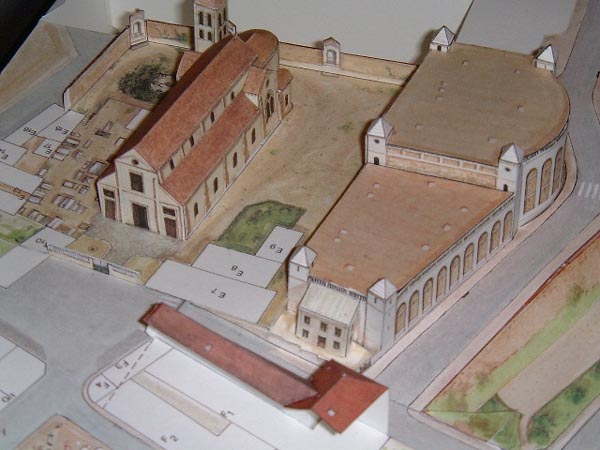
Just starting base buildings
Front view with cover
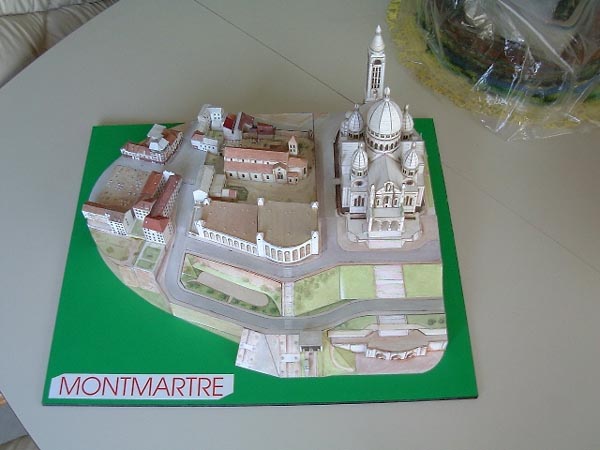
Completed model overall view
This page was created by:
Saul H. Jacobs M.Ed.
Avionics Specialist, United States Air Force (Retired)
Microcomputer Technology, Pima Community College (Retired)
Tucson Arizona